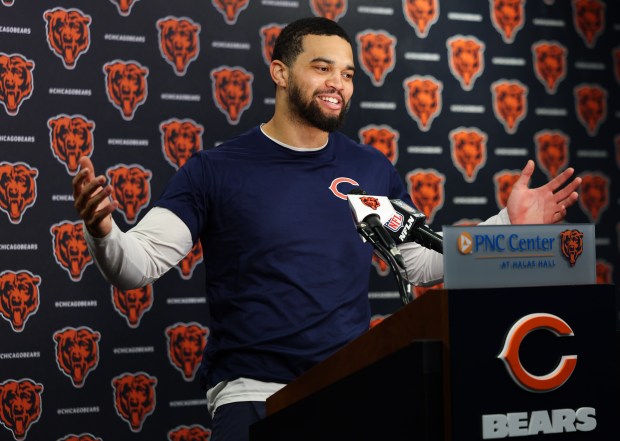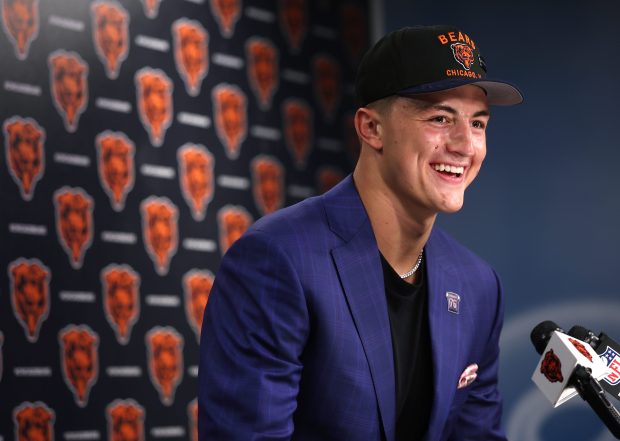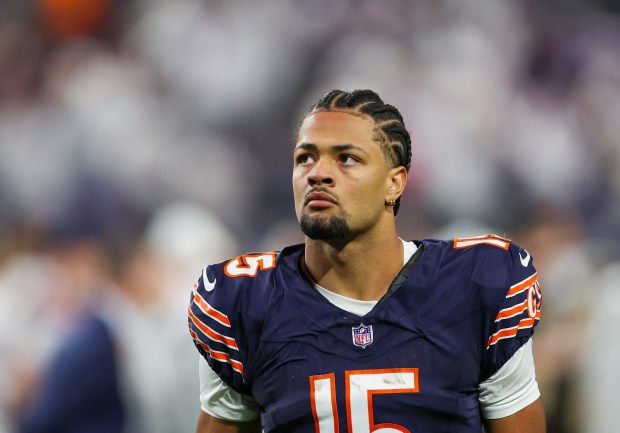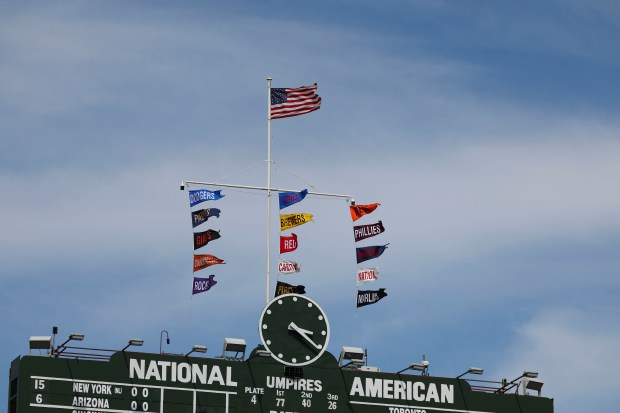The NFL offseason never sleeps.
After the Chicago Bears drafted eight new players two weekends ago, they’ll get their first look at them on the field this weekend during a three-day rookie minicamp at Halas Hall. Then next week brings the much-awaited 2025 schedule release.
Brad Biggs’ weekly Bears mailbag begins with a question about the last of those draft picks.
Watching Kyle Monangai highlights reminded me of David Montgomery’s running style. How do combine stats and college production compare for Monangai and Montgomery? Does Monangai have upside potential comparable to Montgomery’s career? — Ryan Y., Libertyville
Combine measurables for the two running backs are similar. Monangai measured 5-foot-8, 211 pounds with 28¾-inch arms. His 40-yard dash time was 4.60 seconds, and he had a 34½-inch vertical jump and a 9-foot-9 broad jump. At the 2019 combine, Montgomery measured 5-10, 222 with 31 3/8-inch arms. He ran the 40 in 4.63 and had a 28½-inch vertical jump and a 10-1 broad jump.
Neither had impressive 40 times or jump metrics, but the numbers from Indianapolis are just part of the evaluation. It’s more what they did on the field in college. Both were known for playing with good contact balance and vision and running with urgency to get north and south. Montgomery probably has better lower-body quickness and also has a larger frame. One thing scouts noted when I asked about Monangai is his arms are particularly short.
Neither qualifies as a super-high-end athlete, but Montgomery has proved to be a very good NFL running back and arguably has been better in Detroit than he was with the Bears. That’s probably not hard to do behind the Lions offensive line and in a situation where he can remain fresh splitting time with Jahmyr Gibbs.
I think Monangai has a chance to contribute as a rookie. What we don’t know yet is how well he will run with vision and patience in the NFL. We’ll have to wait until they get into training camp to start getting answers. Does he have enough pop in his pads to handle pass protection in the NFL? It’s one thing to block against Maryland. It’s another thing to do it against the Green Bay Packers.
A lot of times, teams make late-round picks based on a player’s traits. I think you can say that about cornerback Zah Frazier, whom the Bears chose in the fifth round out of Texas-San Antonio. He has great height (6-3) and length and he can scoot, timed in 4.36 in the 40 at the combine.
How the NFL draft’s deep class of running backs seemed to dance away from the Chicago Bears
Monangai was more of a pick based on quality production and durability in the Big Ten. He’s not a flier whom the Bears grabbed in the seventh round based on measurables. It was a calculated pick of a back who might have a chance of fitting in, especially if he can play with some of the skills that have made Montgomery super successful as a former third-round pick.
Every year at this time we get excited about a highly drafted Year 2 player that had a mediocre rookie year who is “ready to step up.” Hearing high expectations for Rome Odunze in particular. Not knocking him personally and hope he does take off, but has there ever been a highly touted rookie who underperformed only to turn into a star in Year 2? Having bad flashbacks from when we expected Cade McNown and Kevin White to launch. — Jimmy A.
There’s plenty to tackle here. For starters, it probably isn’t fair to say Odunze had a “mediocre” rookie season, considering everything that went on around him in an offense that was a couple of notches below mediocre. Odunze made 54 catches for 734 yards with three touchdowns. Three rookie wide receivers had big statistical seasons last year: Brian Thomas Jr., Malik Nabers and Ladd McConkey, who is more of a slot receiver. Thomas and Nabers produced in offenses that lacked other targets like DJ Moore.
Odunze showed growth and development as a route runner in the second half of the season. So much was wrong with the offense that it’s probably hard to get a really good snapshot of where he was when the year ended. He needs to be highly productive to justify the No. 9 draft pick. No question about it.
Now he’s in a new offense with a new and experienced play caller who has shown the ability to develop wide receivers. There should be optimism for Odunze heading into Year 2.
As far as highly drafted players who didn’t do a lot in Year 1 and then became highly productive, how about wide receiver Alshon Jeffery? He played in only 10 games with six starts in 2012 and had only 24 catches for 367 yards and three touchdowns as a high second-round pick. He went on to be very good with a 1,421-yard season in 2013.
Why is there a different skill set for a right tackle than a left tackle? — Steve D.
In the 1980s, 1990s and maybe entering the 2000s, offenses looked for an athletic option at left tackle with the footwork needed to handle elite right defensive ends, players who bring a lot of speed off the edge. The prototypical right tackle then was more of a road grader or mauler who would be a great option to run behind, one of the reasons people have said running games are often right-handed.
The game has evolved and now defenses send speed rushers off both edges. That has led offenses to seek athletic players at both left and right tackle. Look at the Lions, who have Taylor Decker at left tackle and Penei Sewell at right tackle. Both are powerful movers who excel in pass protection. I think that’s ultimately what the Bears want to get to. It takes more than one offseason to outfit a new coaching staff with all of the desired pieces.
What games are the best candidates to be played in prime time when the schedule comes out? — Arnie G., Hickory Hills

The NFL will unveil the 2025 schedule on Wednesday, May 14, and my guess is the Bears will be scheduled for four night games. Of course, if they play well, more can be added through the league’s flexible scheduling system.
Mostly by the doing of Bears coach Ben Johnson, it seems he has a little rivalry already brewing with Packers coach Matt LaFleur. That would make a return to prime time for a Bears-Packers game appealing. The teams played a prime-time game for 17 consecutive seasons from 2006 through 2022. It’s probably time for that to be a thing again.
Bears-Lions might be a natural candidate. The Lions will be a hot team for the networks, and they have a lot of potentially intriguing matchups. The Bears and Vikings have tangled on “Monday Night Football” each of the last two seasons and four times since 2020.
In terms of non-division games, games at Washington, Philadelphia, Baltimore, San Francisco and Cincinnati all would have certain appeal for prime time.
Keep in mind not every prime-time game looks like a doozy, at least from a national perspective. The Bears and Panthers played on a Thursday night in 2023. The Bears also played the Commanders on a Thursday in 2022 and 2023 when that wasn’t a super-appealing game outside of the two markets. So there could be a night game scheduled that doesn’t necessarily look like a matchup one of the networks was clamoring to get.
Is it fair to say by not investing a first-round pick at OT the Bears are trying to get by with a serviceable player at left tackle (Braxton Jones/Ozzy Trapilo) rather than a blue-chip player? It will be hard to get an Eagles or Lions OL if that’s the case. — @wickywoowoo1
My first reaction is it would have been a mistake to try to invent a player who wasn’t there when the Bears were picking 10th. The Saints drafted Texas’ Kelvin Banks Jr. at No. 9, and the next offensive tackles to come off the board were Josh Conerly (No. 29 to the Commanders), Josh Simmons (No. 32 to the Chiefs), Aireontae Ersery (No. 48 to the Texans), Anthony Belton (No. 54 to the Packers) and then Trapilo to the Bears at No. 56.
If the Bears’ plan comes up short and Conerly or Simmons develops into a standout left tackle, then they missed. If Ersery becomes a top-flight player, maybe the Bears will regret passing on him at No. 39 when they selected wide receiver Luther Burden III.
I’m not convinced there was a blue-chip left tackle for the Bears to get in this draft, certainly not without trading up. I’d also point out it was going to be impossible for the Bears to build an offensive line this year that’s comparable to what the Eagles and Lions have. Look at how those teams have been built in the trenches and realize it has been done with a consistent approach over a number of years. The Bears took a short cut by trading for guards Joe Thuney and Jonah Jackson, and that will solidify the interior of the line along with signing center Drew Dalman in free agency.
To ultimately get the offensive line to where the Bears want, they’ll need to stay committed to the position for another year or two at least in order to have both the quality and depth required.
Do the Bears plan to move Shemar Turner to the edge? Edge is a priority need despite everyone’s obsession with running backs. — @barbersquires
There may be a chance that Turner lines up at defensive end in occasional (see: rare) pass-rushing situations. I could see that happening once in a while. But Turner — whom the team lists at 6-3, 290 pounds — is a defensive tackle. If things go well, he will develop nicely behind Grady Jarrett and become a stalwart three-technique. Jarrett signed a three-year contract, but you’re essentially looking at a two-year, $30 million deal with a team option for 2027 for a 32-year-old entering his 11th season.
The Bears need to coach up Turner at tackle and let him develop there. Defensive end could be a position they look to supplement later this year — before training camp or potentially after roster cuts. There aren’t a lot of great options right now in terms of unemployed pass rushers.
In third-down passing situations when the Bears use 11 personnel, do you think Colston Loveland is more often the TE in those situations? — @jtbcubs

That probably will be the plan, but the Bears know they can get quality production from Cole Kmet and they have to see how Loveland develops. Tight end is arguably the second-most difficult offensive position for rookies after quarterback. That’s because so much is going on and they are asked to carry a big load with a lot of responsibilities in the passing and running games. Ben Johnson will have an awful lot of flexibility with personnel and it should be fun to see how it develops.
Attention to the draft has bought this issue some time out of the spotlight, but the new stadium issue needs to be resolved. The Chicago lakefront site remains stuck in the mud of Chicago and Illinois politics and, to semi-paraphrase Margaret Thatcher, depends too much on other people’s money. The Bears own a fine site in Arlington Heights. What needs to happen for Kevin Warren to pull the trigger and go ahead with AH? — Dennis G., Colorado
Barring a seismic shift, any stadium project will boil down to “other people’s money,” as you put it. Yes, the Bears have said they would foot the bill for a new stadium in Arlington Heights, but the village or state or both would have to pay for unknown amounts of infrastructure enhancements to make it happen. Is that $1 billion? Less? More? I don’t know. That’s why this entire project is deep, deep in the weeds of politics. The Bears can accurately say they aren’t seeking public money right now to build a new stadium, but the project is a no-go without public money. Unless that changes. Stay tuned.




